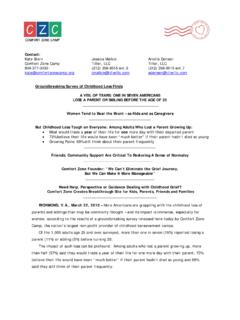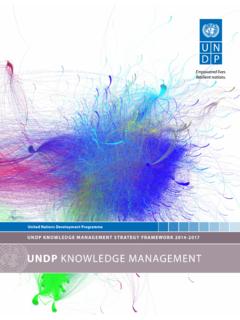Transcription of Credit: Alexius Tan In the Lower Manhattan Financial ...
1 In the Lower Manhattan Financial District Post-Sandy Credit: Alexius TanCHAPTER 1 | SANDY AND ITS IMPACTS10 Sandy and Its ImpactsA stronger , more resilient NEW YORK11By any measure, Sandy was an unprecedentedevent for New york city . Never in its recordedhistory had the city experienced a storm of this size. Never had a storm caused so muchdamage. Never had a storm affected so manylives. As of the writing of this report, individuals,families, businesses, institutions, and, in someways, the city itself are still recovering from this devastating natural disaster and will continue to do so for years. As it turns out, it took an improbable set of factors coming together in exactly the worstway to give rise to the catastrophic impacts ofthis storm. (See sidebar: A Brief History of Sandy)There was, for example, the storm s timing. Itsarrival on the evening of October 29 coincidedalmost exactly with high tide on the AtlanticOcean and in New york Harbor (high tide arrived at the Battery in Lower Manhattan at 8:54 , and the surge peaked there at 9:24 ).
2 This meant that water levels alongmuch of the city s southern coastline alreadywere elevated, with typical high tides aboutfive feet higher than water levels at low , on the night of Sandy s arrival, it was notjust a normal high tide but a spring tide, whenthe moon was full and the tide was at the verypeak of its monthly cycle generally up to halfa foot higher than the average high tide. (See maps: Water Levels Around New york Cityon October 29)Then there was the storm s size. When Sandymade landfall, its tropical-storm-force winds extended 1,000 miles from end to end, makingit more than three times the size of HurricaneKatrina. Storm size the area over whichstrong winds blow correlates closely withstorm surge, the rise in water level caused bythe storm s low pressure and the force of itswinds pushing against the water. (See graphic:Sandy Size and Wind Speed; see graphic: Katrina Size and Wind Speed)Because Sandy was such a massive storm, itgenerated a massive surge.
3 And that surge,coming on top of the spring high tide, createda storm tide of over 14 feet above MeanLower Low Water at the Battery, shattering the previous record of 10 feet, set when HurricaneDonna arrived in New york in 1960. (See chart:High Water Events at Lower Manhattan )Finally, there was the unusual path Sandy tookto the city s shores. Most hurricanes that approach the Northeast glance the coastline orcurve east and head out to sea before they everreach New york . But as Sandy came spinningnorth along the east coast of the United States,winds spiraling counterclockwise, the storm encountered weather systems that caused it totake a different course one that would spelldisaster for parts of the city . A high-pressuresystem to the north blocked the storm s advance. At the same time, a low-pressure system that was pushing eastward towards theAtlantic coast energized the storm and reeledit in. Steered between these two systems,Sandy made a westward turn and headedstraight for land just as it was increasing in intensity.
4 At 7:30 on October 29, 2012,Sandy slammed into New Jersey head-on,seven miles north of Atlantic city , with maximum winds of 80 miles per hour. The storm s angle of approach put New YorkCity in the path of the storm s onshore winds,the worst possible place to be. The winds earlier that day had been blowing in a generallysouthward direction in the New york area. However, as Sandy arrived, its winds shifted,instead moving in a generally northwesterlydirection. It was this shift that helped push thestorm s massive surge and its large, batteringwaves directly at the south-facing parts of the city . As a result of all of these factors, Sandy hit NewYork with punishing force. Its surge and wavesbattered the city 's coastline along the AtlanticOcean and Lower New york Bay, striking withparticular ferocity in neighborhoods acrossSouth Queens, Southern Brooklyn, and the Eastand South Shores of Staten Island, destroyinghomes and other buildings and damaging critical infrastructure.
5 Meanwhile, the naturaltopography of the city s coastline channeledthe storm surge that was arriving from Sandy Size and Wind SpeedKatrina Size and Wind Speed43 6,500 patients evacuated from hospitals and nursing 90,000 buildings in the inundation million New york city childrenunable to attend school for a close to 2 million people without 11 million travelers affected $19 billion in : NASA500 Miles500 MilesA Brief History of SandySandy was no ordinary hurricane. It was a meteorological event of colossal size and impact. It was a convergence of a number ofweather systems that came together in a waythat was disastrous for the New york , however, began innocently enough farfrom New york and almost three weeks beforeits arrival on the area s shores. It was October11, late in the Atlantic hurricane season, whena tropical wave formed off the west coast ofAfrica. By October 22, the wave had evolvedinto a weather system in the Caribbean calledTropical Storm Sandy, the 18th named storm ofthe 2012 hurricane season.
6 (See map: SandyStorm Path)A tropical storm is a cyclone a system ofclouds and thunderstorms rotating around acentral "eye" that originates in tropical waters and gets its energy from those warmwaters. Sandy gained wind speed as it curlednorth. By October 24, it was a hurricane a storm with wind speeds of at least 74 milesper hour (mph) with an eye visible on satelliteimages. Sandy made landfall on Jamaica on October 24 as a Category 1 hurricane then intensified to a Category 3 hurricane beforehitting Cuba on October 25, according to theNational Hurricane Center. While the storm moved across the Bahamas, itweakened to a Category 1 hurricane butbegan to grow significantly in size. It continuedto grow as it traveled north of the islands. Afterpassing the Bahamas, Sandy turned northeast,beginning its trek through the Atlantic Ocean,paralleling the eastern coast of the UnitedStates.
7 Its winds whirled counterclockwise, raising water levels all the way from Florida to Maine. Although most hurricanes on a northward trackalong the US coast continue to hug the coast oreventually curve east and out to sea beforethey reach New york , Sandy encountered twoother weather systems that caused it to shift direction and abruptly intensify yet again. One was a high-pressure system to the norththat blocked Sandy s northward advance. The other was a low-pressure system pushingeastward over the southeastern United States that reenergized Sandy. Steered between these two weather systems, Sandyturned sharply west just as it was reaching another peak of intensity. When Sandy made landfall in Brigantine, New Jersey, just north of Atlantic city , at 7:30 on October 29 with 80-mph winds,it was technically no longer a hurricane.
8 Two-and-a-half hours before it had made landfall, the National Hurricane Center had reclassified Sandy as a post-tropical cyclone because the storm had evolved in such a waythat it no longer possessed the technical characteristics of a hurricane: It lacked strongthunderstorm activity near its center; its energydid not come from warm ocean waters butfrom the jet stream; and it had lost its eye. No matter what Sandy was called, though, thestorm never lost its large wind field or its largeradius of maximum wind (which is why weatherexperts still considered it a hurricane strike when it hit the New york region). In fact, whenthe storm made landfall, its tropical-storm-forcewinds extended 1,000 miles three times thatof a typical hurricane. It was those winds, as well as the storm s low pressure, that wereresponsible for its catastrophic storm surge. The storm s angle of approach was also significant.
9 Because Sandy came at the coast of New york at a perpendicular angle, its counterclockwise onshore winds drove the surge and the surge's large, batteringwaves directly into the city s landfall, Sandy slowed and weakenedwhile moving through southern New Jersey,northern Delaware, and southern finally lost its defined center while passingover northeastern Ohio late on October 31. For the next day or two, what remained ofSandy continued over Ontario, Canada beforemerging with a low-pressure area over easternCanada and heading out to sea for that point, of course, New york still was reeling from the storm s effects and wasonly beginning to cope with the extent of the damage. San dy Storm PathSandy by the NumbersSandy made landfall three times: at Bull Bay, Jamaica, on October 24; at Santiago deCuba, Cuba, on October 25; and finally at Brigantine, New Jersey, on October 29 The storm s wind speed was 80 mph at landfallin New wind field extended for 1,000 the US, $50 billion in total damages have been attributed to the storm, making it more costly than any other storm except Hurricane Andrew in 1992 and Hurricane Katrina in : National Oceanic and Atmospherics Administration/Department of CommerceCHAPTER 1 | SANDY AND ITS IMPACTS12A stronger , more resilient NEW YORK13the ocean northward into New york Harbor, elevating water levels in Jamaica, Sheepshead,Gravesend, and Gowanus Bays, as well as inUpper New york Harbor and the East and Hudson Rivers.
10 At the same time, the stormsurge also was pushing water into Long IslandSound, and from there south. In short, the ocean fed bays, the bays fed rivers,the rivers fed inlets and creeks. Water rose upover beaches, boardwalks, and bulkheads. It was an onslaught of water. In total, a staggering 51 square miles of New york city flooded 17 percent of the city stotal land mass. The floodplain boundaries onthe flood maps from the Federal Emergency Management Agency (FEMA) in effect whenSandy hit had indicated that 33 square milesof New york city might be inundated during a so-called 100-year flood, or the kind of flood estimated to have only a 1 percent chance of occurring in any given year. However, Sandy sstorm tide caused flooding that exceeded the100-year floodplain boundaries by 53 percentcitywide. In Queens, the area Sandy flooded was almost twice as large as the floodplain area indicated on the maps.

















